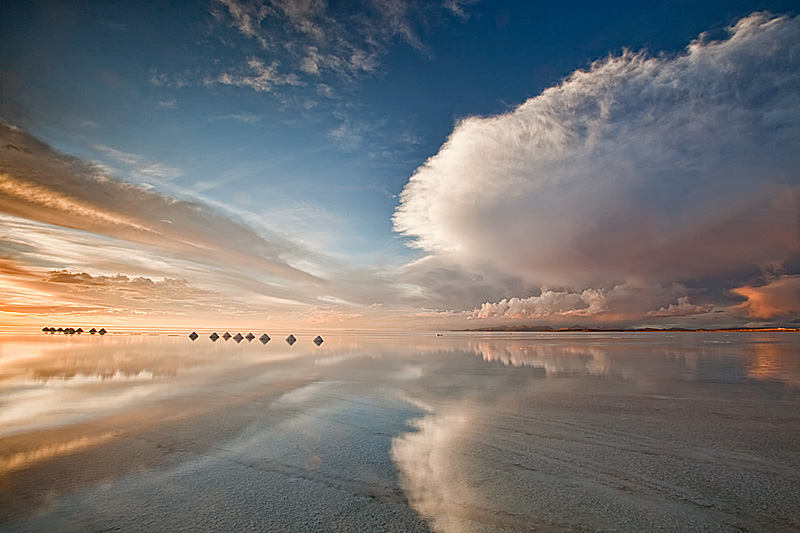Salar de Uyuni (or Salar de Tunupa), located in southwest Bolivia, near the crest of the Andes, is one of the most visually captivating place in South America. Photographers flock here everyday to capture the stunning landscape created by amazing geological formations, geothermal springs and brine lakes. Covering an area of 10,582 square kilometers, it is the world’s largest salt flat. Salar de Uyuni is estimated to have a reserve of 10 billion tons of salt.

Some 30 to 40 thousand years ago, this area was part of a giant prehistoric lake called Lake Minchin. The lake underwent a series of transformation between several vast lakes, and when it dried, it left behind two modern lakes, Poopó Lake and Uru Uru Lake, and two major salt deserts, Salar de Coipasa and the larger Salar de Uyuni.

In the dry season, the salt planes are completely flat expanses of dry salt, but during the wet season, the neighboring Lake Poopó overflows and floods Salar De Coipasa and Salar de Uyuni covering both deserts with a thin sheet of water that looks magnificent under the vast open sky.Underneath the surface of the Salar is a lake of brine 2 to 20 meters deep. The lake is covered with a solid salt crust with a thickness varying between tens of centimeters to a few meters.

The center of the Salar contains a few “islands”, which are the remains of the tops of ancient volcanoes which were submerged during the era of lake Minchin. They include unusual and fragile coral-like structures and deposits that often consist of fossils and algae. Due to heavy amount of salt in this region the hotels are build from the salt.In the wet season, the Poopó Lake overflows into Salar de Uyuni turning it into the worlds largest mirror.

The Salar contains large amounts of sodium, potassium, lithium and magnesium as well as borax. With estimated 5,400,000 tonnes, Bolivia holds about half of the world’s lithium reserves, most of those are located in the Salar de Uyuni. Despite the large reserve, there is currently no mining plant at the site, as the Bolivian government doesn’t want to allow exploitation by foreign corporations. Instead, it intends to build its own pilot plant with a modest annual production by 2012.Salar de Uyuni is estimated to contain 10 billion tonnes of salt, of which less than 25,000 tonnes is extracted annually.
by hathurway.com
 World Insights Bringing You best of world at one place
World Insights Bringing You best of world at one place